Gina Fischli – Rabies Babies
DAS GERICHT, Frankfurt am Main
by Miriam Wierzchoslawska
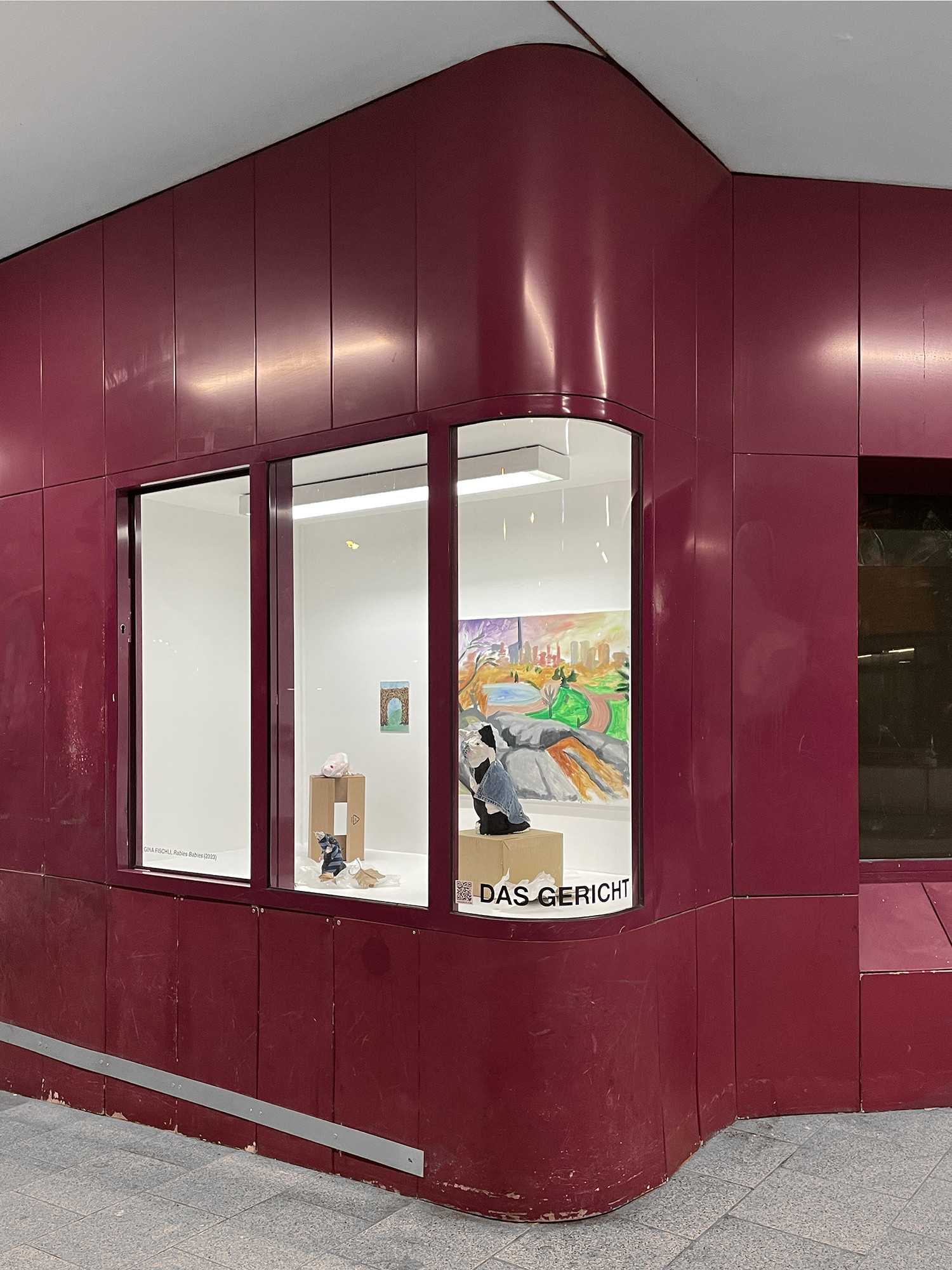
Gina Fischli, Rabies Babies, 2023. Exhibition view DAS GERICHT, Frankfurt a.M.
“I saw a Heffalump today, Piglet.”
“What was it doing?” asked Piglet.
“Just lumping along,” said Christopher Robin. “I don’t think it saw me.”
“I saw one once,” said Piglet. “At least, I think I did,” he said. “Only perhaps it wasn’t.”
“So did I,” said Pooh, wondering what a Heffalump was like.
“You don’t often see them,” said Christopher Robin carelessly.
“Not now,” said Piglet.
“Not at this time of year,” said Pooh. [1]
About midway through Disney’s 1968 Winnie the Pooh and the Blustery Day, we find Pooh falling asleep and entering a nightmarish dream sequence. Here he encounters heffalumps and woozles, frightening creatures that attempt to pilfer his oh-so-prized honey. [2] Unlike the other characters depicted in the Hundred Acre Woods, the heffalumps and woozles are made up of a patchwork of fabrics, upholstered in garish tweed, polka dot and plaid patterns, with visible stitching, Frankenstein-like in their messy construction. They shift and transform between animal-like figures and functional objects—an incoherent mixture of watering cans, balloons, trumpets, canons, etc., bombarding Pooh with a series of psychedelic tricks and transformations as they surreptitiously attempt to steal his honey. Throughout A. A. Milne’s books, both heffalumps and woozles only ever appear in the characters’ dreams and imaginations. Whether they come alive as the spectres of Piglet’s anxieties or the subject of cautionary tales, their presence always lingers in the background as myth, haunting Christopher Robin’s various storylines. The heffalumps’ presence is marked by their physical absence—a figment of imagination unconsciously rendered real by unfounded fears. Their relegation to the oneiric and the compulsive is a marker of their otherness, and as a container or a manifestation for the various collective anxieties and neuroses of the principal protagonists. [3] The animal-like characters populating Rabies Babies, Gina Fischli’s solo show at DAS GERICHT, obliquely point to these anxieties, drawing out a feeling of alienating unease that accompanies their comparatively cute appearance. Like poorly taxidermied specimens, their appearance lies somewhere between toy and scarecrow.
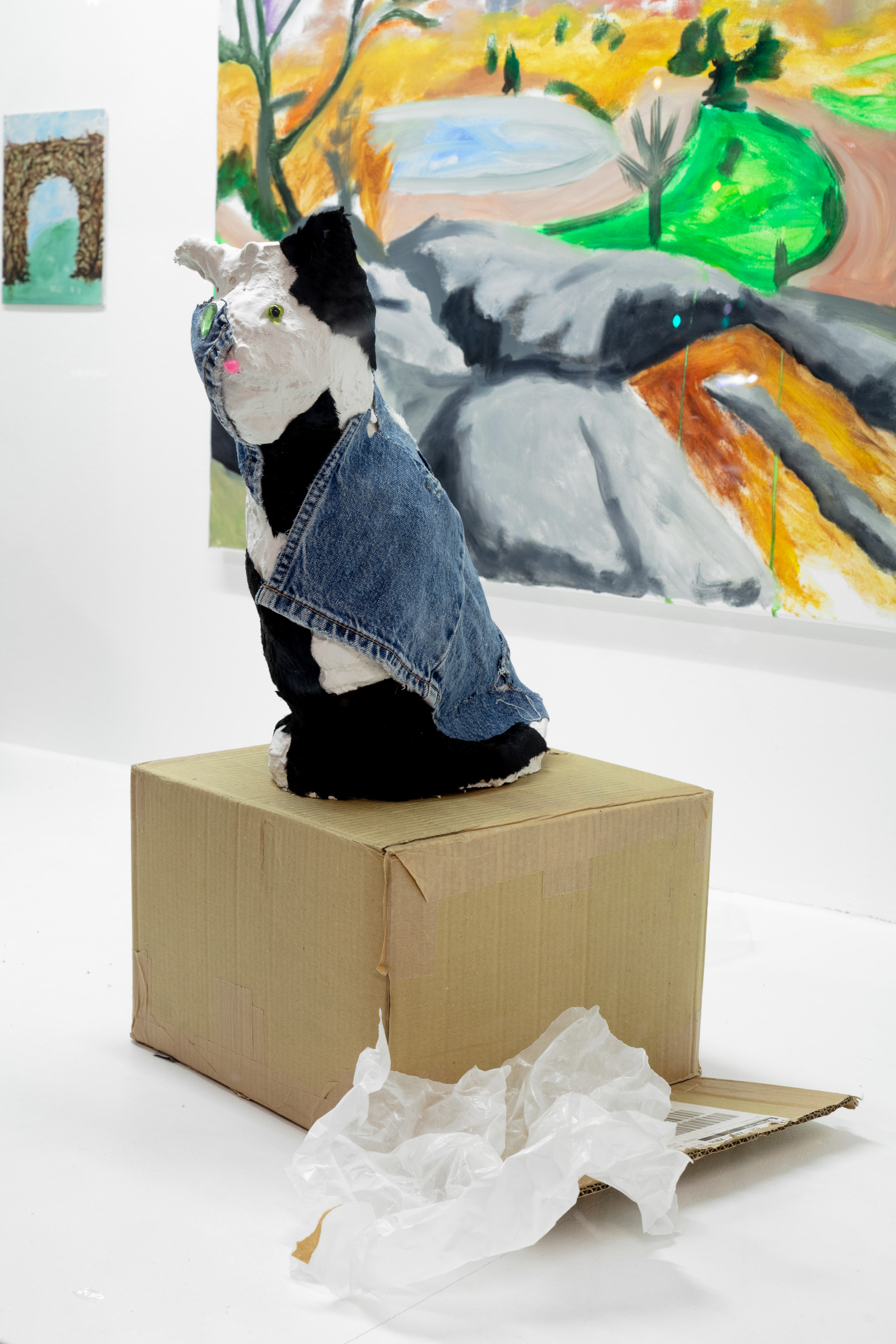
Gina Fischli, Gina. Photography: Tobias Still
Around midnight, bleary eyed and exhausted after an earlier trip from Berlin that day, I stumbled onto the intersection of Konrad-Adenauer-Straße and Vilbeler Straße in Frankfurt. At the very corner, wrapped by a curved glass window pane, sits the work of Gina Fischli: a glowing set of three dioramas, each populated by recognizable urban critters, fashioned from what appears to be old clothes and rags, packaging and other disused objects. A cat, a mole, a crow, some rats—each peering back at me through the vitrines. The animals’ prior existence as functional objects points to the thin distinction that might separate them from the everyday commodities they once were. The works’ placement in a traditionally commercial space only amplifies this. Like Pooh’s heffalumps, their figures are lumpy and unstable. One could easily imagine them unravelling, returning back to their previous forms. Inside, Fischli has hung paintings of rough and what appears to be rapidly produced depictions of cityscapes. They sit on the back wall of the vitrines like a second layer of little windows, opening out onto sets of urban landscapes that could act as stand-ins for any generic metropolitan environment. There’s a painting of what appears to be Washington Square Arch, Arc (2023), or upon closer inspection a shrub-like facsimile that might serve as a nesting spot for the crow in the foreground. In the adjoining vitrine is another view, Primrose Hill (2023), which could also very well be Toronto or Seattle. The views all have parks in the foreground. It is unclear if the landscapes Fischli has painted are perceived through the eyes of her “babies” or rather as generic forms of urban representation found on postcards or billboard advertisements. The ambiguity points to an uncertain sense of subjectivity the artist wrestles with in regard to her works. Fischli further underlines this by naming the cat sculpture Gina (2023) after herself.
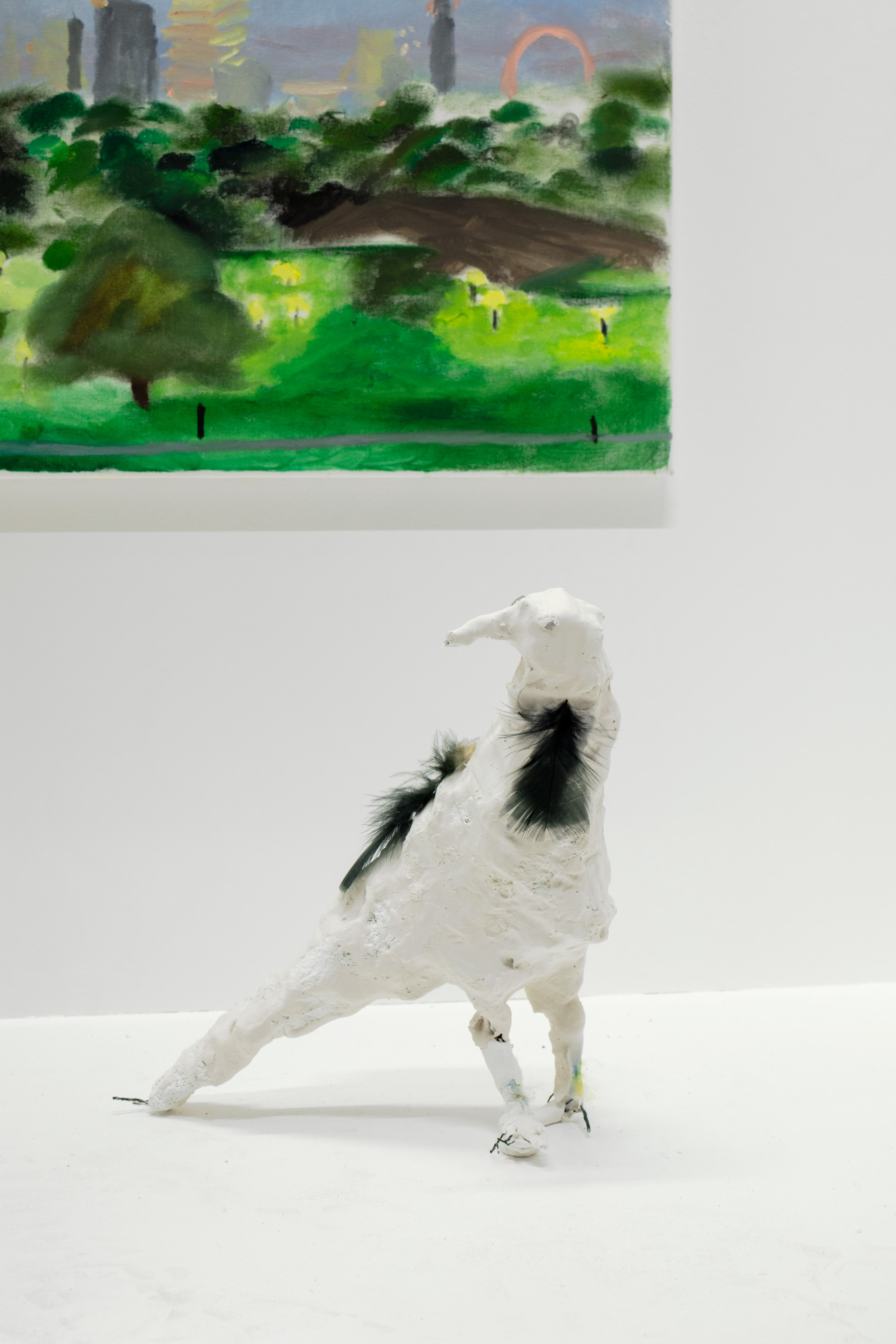
Gina Fischli, Crow. Photography: Tobias Still
The resulting boundary between the city, its image, and the interior of the vitrine is reduced, almost permeable. Even the flies circling about, bumping into the glass pane in search of the fluorescent lights have made it through. On the interior, their dead sun-bleached counterparts lay strewn amongst Fischli’s sculptures. The degree of separation between DAS GERICHT and its environment is not as stark as other exhibition spaces. Curated by Leonie Herweg as part of an ongoing series of exhibitions, the show is located in a postmodern parking lot, clad in a metal magenta panelling that wraps around the ground floor. The exhibition is embedded in the urban infrastructure of Frankfurt. An arcade populated by shop windows circles the perimeter of the building. Fischli’s display acts as a dioramic mise-en-abyme, whereby the image and setting of the city, as well as its function as a potential commercial space, is recursively repeated within the setting of the exhibition.
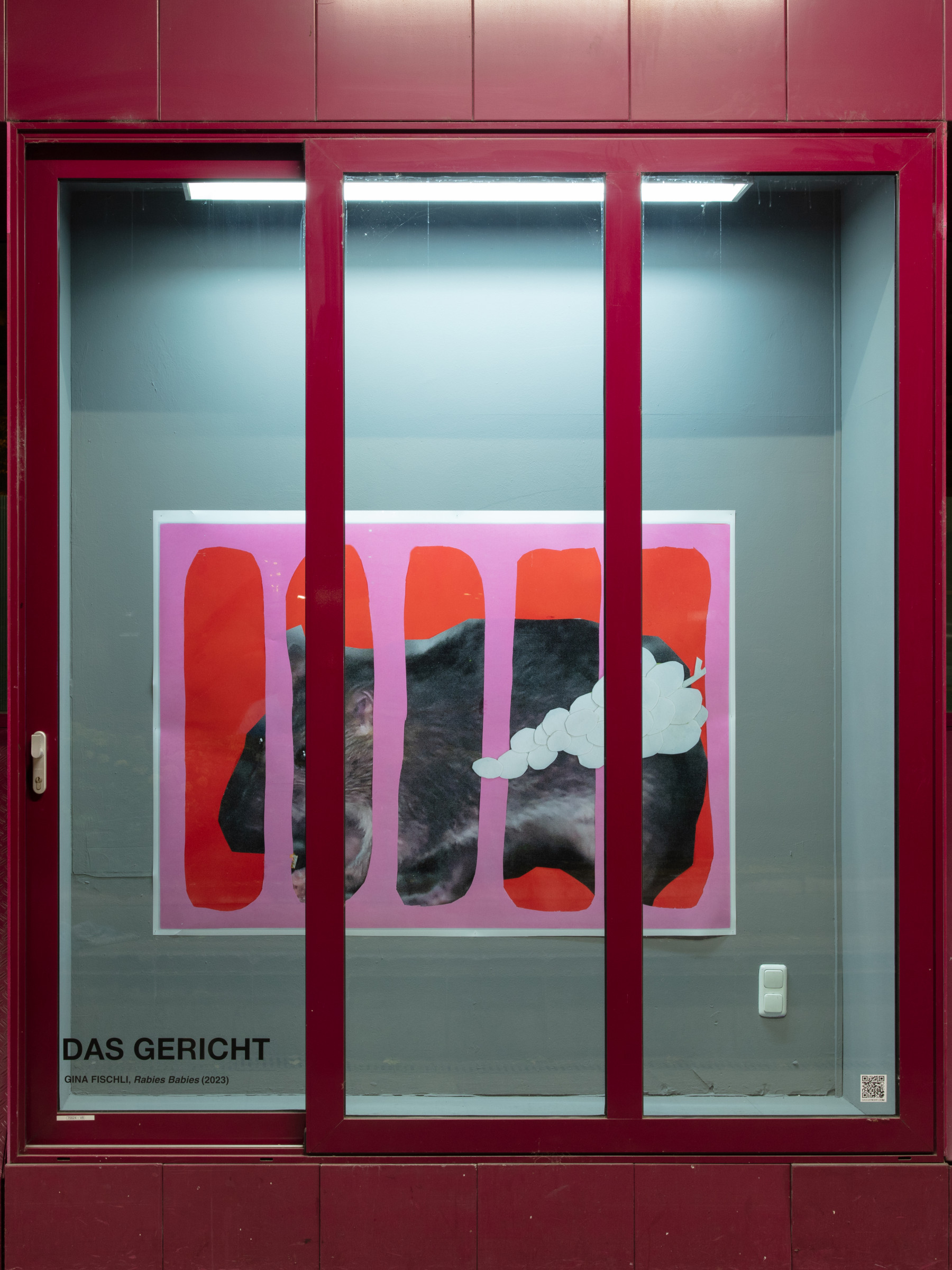
Gina Fischli, Rabies Babies, 2023. Exhibition view DAS GERICHT, Frankfurt a.M. Photography: Tobias Still
This recursivity is further amplified in the collage Rat Print (2023) that acts as a condensation of the whole show. In it, Fischli duplicates the frames of the pink vitrines that house the work. Behind the doubling of the pink mullions is a photographic cut-out of a rat. One can tell that the image has gone through several layers of processing: cutting, assembling, scanning, editing, printing. The image functions as a collapsed, two dimensional score for the procedures that Fischli has enacted on the animals within the other two vitrines. The rat has been captured, shot (with a camera), flattened into a cropped composition and edited. It is taxidermied with paper rather than upholstery. The similarity between shooting a photographic image and hunting with a gun comes to mind. Loading, aiming, zooming in, adjusting focus and pulling the trigger/shutter button are inherent to both. They are rooted in the same desire to capture and possess. [4] In this case Fischli's output is an image rather than a sportsman’s trophy.
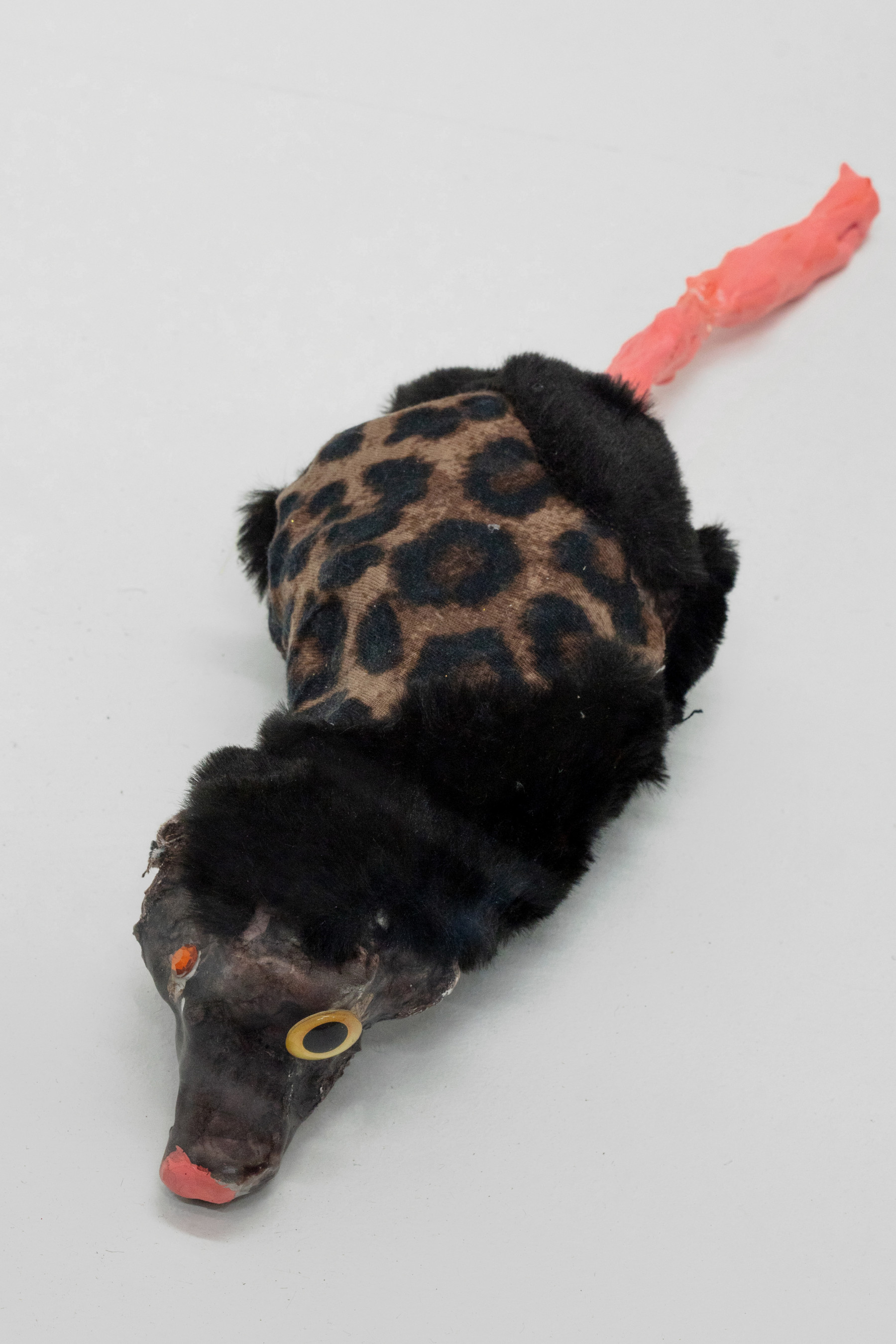
Gina Fischli, Tiger. Photography: Tobias Still
The vitrines reference dioramas found in most natural history museums. Rather than presenting wild or exoticised animals that have been shot, transported from their habitats, and taxidermied back to life in Western institutions, Fischli has chosen to depict our familiar pests—the semi-domesticated urban companions that we interact with daily. At once raising their scruffy existence to the level of something worthy of examination, Fischli’s dioramas also act as narrative links between our imaginings of the city and the sense of uncanniness that lurks in their dark corners. The fraught relationship between most city residents and their furry, scaly, and feathered co-inhabitants is nothing new. There is a notion of control and purging inherent in this conflict—keeping disease and material destruction at bay for the preservation of collective health and personal property. Pioneered by planning figures such as Georges-Eugène Haussmann, Frederick Law Olmsted and Ebenezer Howard, amongst others, ideas of conservation, preservation, and objectification rooted in the Industrial Revolution of 18th and 19th century still underpin most of our inherited urban planning today. [5] The resulting infrastructures of our cities are very much involved in the management of the urban critters within them.
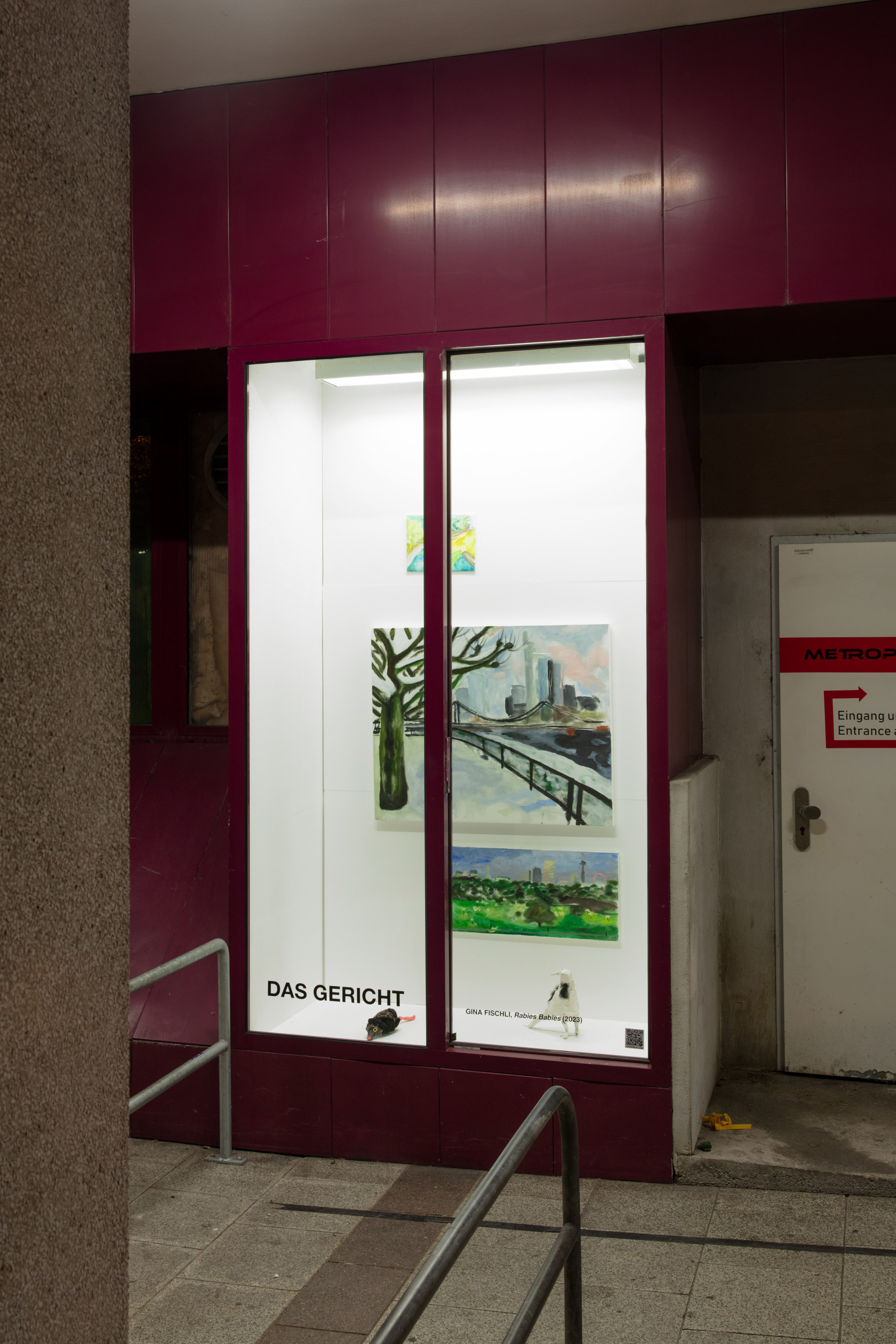
Gina Fischli, Rabies Babies, 2023. Exhibition view DAS GERICHT, Frankfurt a.M. Photography: Tobias Still
These forms of control are expressed in their most extreme form with the ritual of the hunt. Survival aside, romanticised stories of the hero hunting and slaying the beast are some of the oldest and foundational narratives amongst cultures. Even in Pooh’s adventures most of the stories are framed and focused on hunting down and capturing the heffalumps, woozles, and thesauruses that roam the periphery of Pooh’s mind. Culling is perceived as necessary—but hunting where the objective for man is to confront his own mortality and subjectivity through the “sublime confrontation” in the destruction of the other has persisted as a romanticised ideal. [6] Whether narratives such as Mary Shelley’s Frankenstein or in Thomas Pynchon’s V, wherein Benny Profane is hired by New York City’s Street Department to hunt down the alligators in the sewer system, the moment of the encounter with the other is always the point at which the protagonist is able to delve internally and perceive previously unknown aspects of the self.
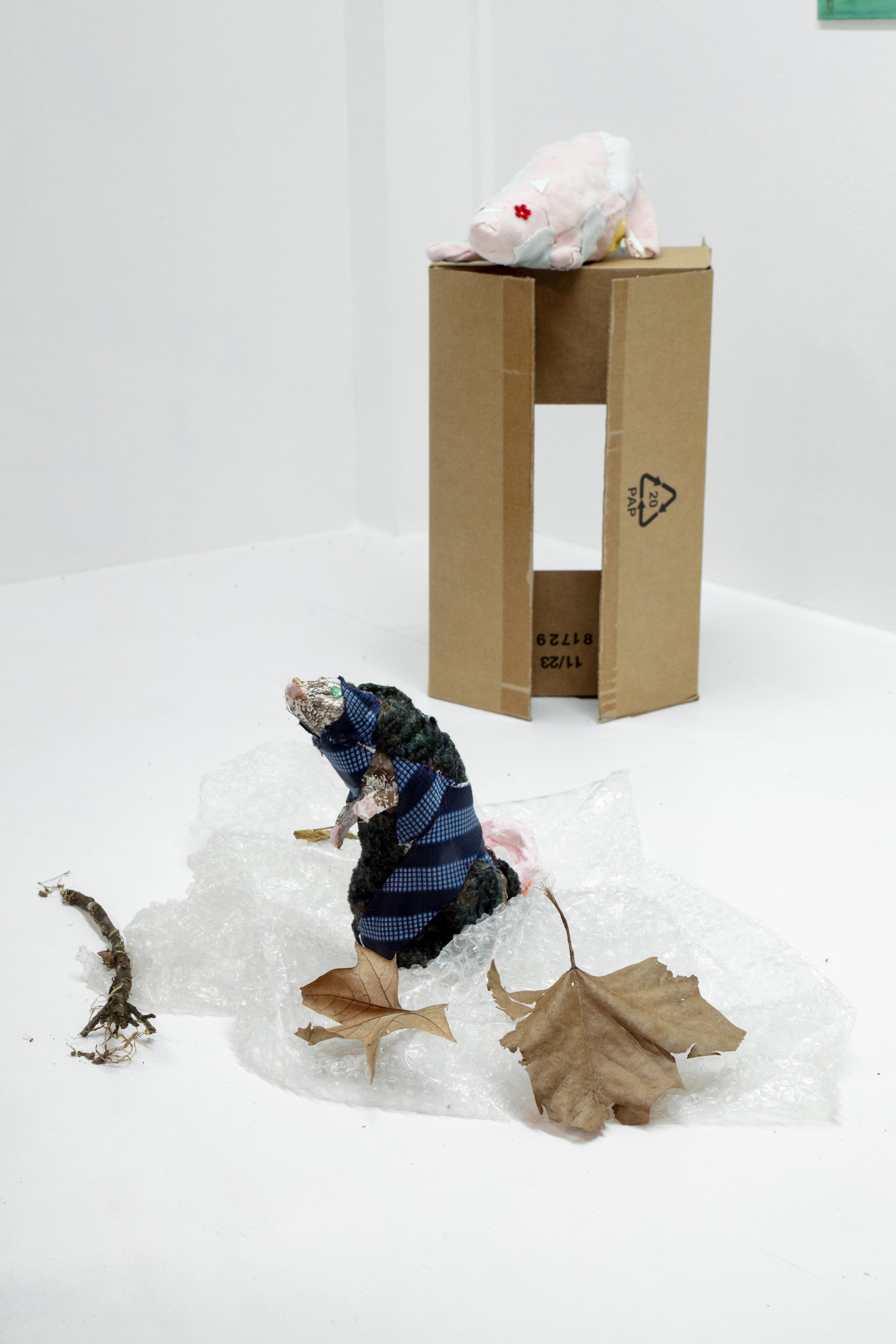
Gina Fischli, Rabies Babies, 2023. Exhibition view DAS GERICHT, Frankfurt a.M. Photography: Tobias Still
In her accompanying exhibition text, Olga Hohmann recounts how the various rumours and urban myths that permeate the narratives of our cities become the substance that underpins our material reality. [7] She brings up Benjamin's Arcades Project, where he describes how the newly built galleries and structures of Paris have led to a new type of commercial function of public space. In order for this heightened form of urban capitalist encroachment to be successful, new narratives and myths around the production and circulation of goods must be constructed. [8] Similarly in New York, the urban myth of the sewer alligators is very much the byproduct of uninformed overconsumption—the result of manufactured desire that has had to be disposed of. A type of unceremonious potlatch. The alligators’ imaginary presence is always haunting the streets of New York, just as the heffalumps haunt the Hundred Acre Woods. During Pynchon’s alligator hunt, Benny has a revelation some time after shooting and killing the alligator he’d been chasing. He comes to the conclusion that because of their origin as a products, the alligators, once free in the sewers, desire to return to their former state as commodity; that “... in some prehistoric circuit of the alligator brain they knew that as babies they’d been only another consumer-object, along with the wallets and pocketbooks of what might have been parents or kin, and all the junk of the world’s Macy’s. And the soul’s passage down the toilet and into the underworld was only a temporary peace-in-tension, borrowed time till they would have to return to being falsely animated kids’ toys. Of course, they wouldn’t like it. Would want to go back to what they’d been; and the most perfect shape of that was dead—what else?—to be gnawed into exquisite rococo by rat-artisans ...” [9]
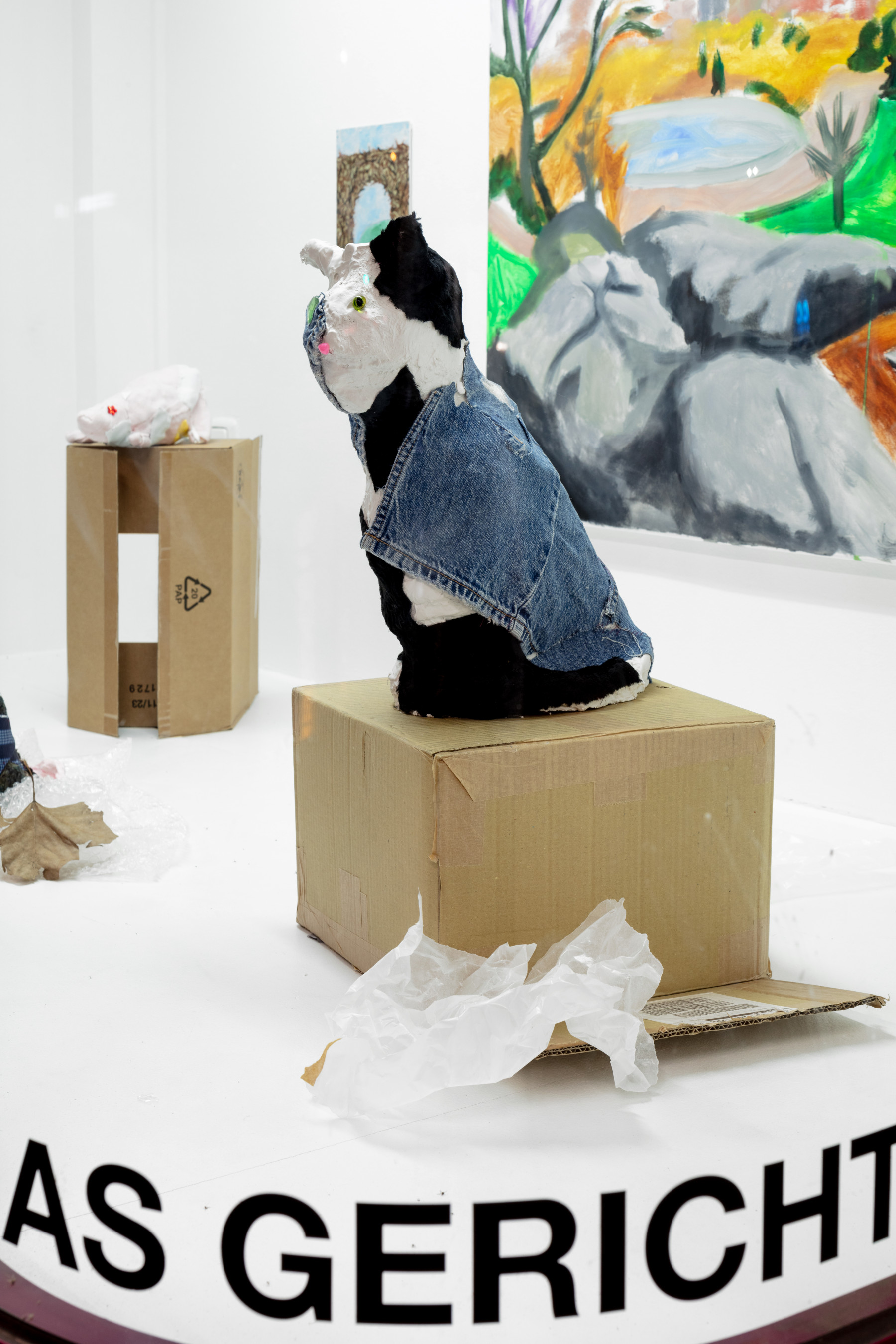
Gina Fischli, Rabies Babies, 2023. Exhibition view DAS GERICHT, Frankfurt a.M. Photography: Tobias Still
Dioramas are meaning-machines. [10] But whether this form of artificial reification through death is really an effective mode of representation is another question. One must kill the subject for it to once again be reified within the display of an exhibition setting. Or as Adorno famously observed, the tenuous boundary between museum and mausoleum collapses once an artefact or specimen is isolated within the exhibition setting. [11] We project our worst nightmares on animals, partially because their consciousness is inaccessible to us. They become effigies or stand-ins for undesired parts of ourselves. We ascribe them narratives and nightmares to distance ourselves from our own dark thoughts. Fischli’s works are stuffed and upholstered with these projected anxieties. In some sense they demonstrate our penchant to understand the other through destructive observation. [12]
[1] A. A. Milne, Winnie-the-Pooh, E. P. Dutton, 1926, p. 56.
[2] Thesauruses, heffalumps, and woozles are the result of child’s mispronunciation and misunderstanding of other words (stegosaurus, elephant and weasel respectively). They are the mysterious characters that are blamed for attempting to steal Winnie the Pooh’s honey and are often the antagonists of Pooh’s and Christopher Robin’s many adventures.
[3] Michael Rubenstein and Justin Neuman, Modernism and its Environments, Bloomsbury 2020, p. 110.
[4] Donna Haraway, Teddy Bear Patriarchy: Taxidermy in the Garden of Eden, Social Text, No. 11 (Winter, 1984–1985), p. 38-42.
[5] Ibid, p. 57.
[6] Ibid, p. 26.
[7] Olga Hohmann, See you later, alligator, exhibition text Rabies Babies at DAS GERICHT, Frankfurt, 2023.
[8] Walter Benjamin, Arcades Project, Harvard University Press 1999, p. 31-61.
[9] Thomas Pynchon, V, J.B. Lippincott 1963.
[10] Donna Haraway, Teddy Bear Patriarchy, p. 52.
[11] Theodor W. Adorno, Valery Proust Museum, Neville Spearman 1967, p. 175.
[12] Ibid, p. 176.
RABIES BABIES
Gina Fischli
20/05 – 24/06/2023
Curated by Leonie Herweg
DAS GERICHT
Konrad-Adenauer-Straße 15
Vitrine 4/8
60313 Frankfurt am Main